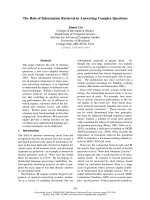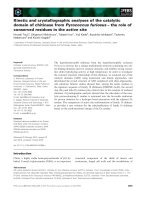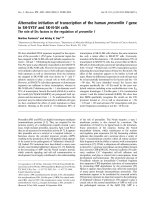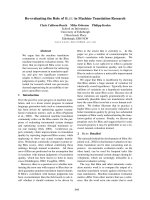The role of transport infrastructure in attracting FDI in china a regional analysis
Bạn đang xem bản rút gọn của tài liệu. Xem và tải ngay bản đầy đủ của tài liệu tại đây (637.21 KB, 56 trang )
THE ROLE OF TRANSPORT INFRASTRUCTURE
IN ATTRACTING FDI IN CHINA:
A Regional Analysis
ZHU LICHAO
(MASTER OF SOCIAL SCIENCES), NUS
A THESIS SUBMITTED
FOR THE DEGREE OF MASTER OF ECONOMICS
DEPARTMENT OF ECONOMICS
NATIONAL UNIVERSITY OF SINGAPORE
2011
Acknowledgement
I would like to express my deepest appreciation to those who have helped me
with this thesis.
I owe sincere gratitude to my most respected supervisor, A/P Anthony Chin,
for his patience, encouragement and illuminating guidance. Through the
writing of this thesis and the presentation, he has spent much time in
correcting my draft and offered me many valuable suggestions. Without his
help, this thesis could not have been completed.
I would also like to thank A/P Liu Haoming and A/P Tomoo KIKUCHI, for
their insightful inputs and advice during presentation of this thesis.
I also want to thank Liu Yuhai, Cliff, Lu Yunfeng and Zeng Ting, for the
discussions and help on this research.
i
Content
Acknowledgement ......................................................................................................... i
Abstract ........................................................................................................................iii
List of Tables................................................................................................................ iv
List of Figures .............................................................................................................. iv
1.
Introduction ........................................................................................................... 1
2.
Literature Review .................................................................................................. 7
2.1 Comparative Advantage Theory ...................................................................... 8
2.1.1 Size of Local Market ............................................................................ 8
2.1.2 Labor Market Conditions ...................................................................... 9
2.1.3 Degree of Openness ............................................................................ 10
2.2 New Economic Geographic Theory .............................................................. 11
2.2.1 Agglomeration Effect .......................................................................... 11
2.3 New Institutional Economics Theory and Policy Incentive .......................... 12
2.3.1 Policy .................................................................................................. 12
2.3.2 Infrastructure....................................................................................... 13
2.4 Summary ....................................................................................................... 15
3.
Empirical Framework and Data .......................................................................... 18
3.1 Empirical Model Set-up ................................................................................ 18
3.2 Data Availability ............................................................................................ 23
4.
Results and Interpretations .................................................................................. 25
4.1 Results without transport infrastructure spillover effect ............................... 25
4.2 Results taking into account transport infrastructure spillover effect ............. 31
5.
Conclusion and Policy Implication: .................................................................... 35
References ................................................................................................................... 37
Appendix ..................................................................................................................... 46
ii
Abstract
This study investigates the relative importance of transport infrastructure in
attracting FDI to three different regions in China based on 28 Chinese
provincial economies from 1995 to 2008. Using fixed effect panel data
approach, transport infrastructure is seen to have contributed to the relative
attractiveness of the provinces, especially in west and middle regions, while
the effect is not significant in the east region. The impact of other forms of
infrastructure, such as telecommunication infrastructure, seems to exhibit
similar positive impact, though to a lesser extent. Consistent with previous
studies, other variables such as agglomeration effect, market size and policy
incentive yielded the expected signs and results and seem as main drivers of
FDI. Regional differences exist. Very interestingly, the extent and presence of
good transport infrastructure in neighboring provinces have a significantly
positive impact on local FDI decision.
Key words: transport infrastructure, FDI, telecommunication infrastructure,
regional differences, spillover effect
iii
List of Tables
Table 1: Descriptive Statistics ............................................................................. 24
Table 2: Correlation Matrix ................................................................................. 25
Table 3: Impact of FDI determinants without spillover effect of transport
infrastructure ................................................................................................ 26
Table 4: Impact of FDI determinants with spillover effect of transport
infrastructure ................................................................................................ 32
List of Figures
Figure 1: China‟s map consisting of the three regions .......................................... 5
Figure 2: Real FDI Inflow (1995-2008) East China ............................................ 46
Figure 3: Real FDI Inflow (1995-2008) Middle China ....................................... 47
Figure 4: Real FDI Inflow (1995-2008) West China .......................................... 48
Figure 5: Real FDI Inflow Growth Rate and Transport Infrastructure Growth Rate
(1996-2008) East China ............................................................................... 49
Figure 6: Real FDI Inflow Growth Rate and Transport Infrastructure Growth Rate
(1996-2008) Middle China .......................................................................... 50
Figure 7: Real FDI Inflow Growth Rate and Transport Infrastructure Growth Rate
(1996-2008) West China .............................................................................. 51
iv
1. Introduction
The past decade has witnessed foreign direct investment as an important
engine for China‟s economic growth, with FDI increasing from 1.96 billion
USD in 1985 to 92.4 billion USD in 2008 (Chinese Statistical Yearbook).
China moved from restrictive to reformed policies in the early 1980s. From
the mid 1980s the focus was on encouraging FDI in general. The focus shifted
to encouraging more high-tech and more capital-intensive FDI projects in the
mid-1990s (Fung et al., 2004). During the reformed period, the Chinese
government established four Special Economic Zones (SEZs) in Guangdong
and Fujian provinces and offered special-incentive policies to FDI in these
SEZs. While FDI inflows were highly concentrated within these provinces, the
amount remained rather limited (Cheung and Lin, 2004). After 1984, Hainan
Island and 14 coastal cities across ten provinces were „opened‟, and FDI levels
really started to take off. The realized value of inward FDI to China reached
3.49 billion USD in 1990. The preferential regimes policy resulted in an
overwhelming concentration of FDI in the east. The expected spillover effects
from coastal to inland provinces failed to materialize. In reaction to the
widening regional gap, more broadly-based economic reforms and open door
policies were advocated in the 1990s. By the second quarter of 1992, Deng
Xiaoping adopted a new approach which turned away from special regimes
1
toward a more nationwide implementation of open policies for FDI inflows.
New policies and regulations encouraging FDI inflows were implemented and
produced remarkable results. Since 1992 inward FDI in China has accelerated
and reached a peak level of 45.5 billion USD in 1998. After a drop due to the
Asian crisis, FDI inflows into China surged again, so that by 2003 China
received more than US$50 billion in FDI, surpassing the United States to
become the world‟s largest single recipient of FDI (Forbes, 2005). China‟s
entry to the WTO in 2001 enhanced its integration in the international
economy and reinforced the FDI attractiveness of China. Now the crucial issue
for China‟s policy makers is to guide FDI to disadvantaged areas such as west
and middle provinces given severe regional economic development disparities
between coastal and interior regions.
Transport infrastructure development gap represents one of the regional
inequality problems among Chinese provinces. Transport infrastructure
improvements help to attract FDI through reduction in monetary and time
costs of procurement of primary and intermediate inputs and distribution of
finished products.
Most studies on the determinants of FDI look at the impact of general
infrastructure without differentiating the effect of transport infrastructure from
that of other forms of infrastructure. In addition, the existing literature
2
generally paid little attention to regional variations of FDI location
determination mechanisms. As east region is not in the same level in terms of
market size, transport infrastructure and early year‟s policy support when
comparing with the other two regions, the important FDI location
determination factors in east region may not work the same way in middle and
east regions. Furthermore, with regard to research on the spillover effect of
transport infrastructure in determining FDI decision, there is an even greater
dearth of literature, among the very few being Yang et al. (2010), while some
studies demonstrate the existence of spillover effect of transport infrastructure
in economic growth and productivity (Hulten, 2004). Given these
considerations, evidence on how the transport infrastructure in different
Chinese regions influences foreign investors‟ decision making remains
incomplete.
This study aims to provide a detailed analysis of the role played by transport
infrastructure in attracting FDI in three different regions. FDI data at the
provincial level for the period 1995-2008 was employed in this study. This is
the period in which FDI spread from highly concentrated Pearl River Delta
(PRD), and hence Guangdong province, towards other eastern regions as well
as recently the western and middle provinces (Chan et al., 2008). Before the
econometric model is made, I first explore the economic theories such as
regional comparative advantage theory, new economic geography theory, new
3
institutional economics theory and the related empirical literature, and
comprehensively identify the potential determinants which can explain the
spatial distribution of FDI in China and format two hypotheses on transport
infrastructure.
Panel data regressions employing fixed effect approach to control for province
specific effects and time fixed effects were then carried out. The results are
summarized as follows: First, transportation infrastructure has been a
significant determinant in making the province attractive to foreign direct
investors and this impact is much more prominent in west and middle regions
than that in east region. A similar pattern is also observed for non-transport
infrastructures. Second, the result confirms the existence of transport
infrastructure spillover effect in attracting FDI, suggesting that a
comprehensive network in neighboring province has had a significant positive
impact on local FDI inflows. Third, market size is a very important factor in
attracting FDI in the east region while policy incentive is more prominent in
middle and west regions. A China‟s map consisting of the three regions is
shown in Figure 1.
4
Figure 1: China’s map consisting of the three regions
Middle Region
West Region
East Region
5
By providing an assessment of the relative importance of transport
infrastructure to FDI location decision in different regions, this study provides
some guidance on the kinds of policy instruments that would be most
successful in attracting FDI to disadvantaged regions. This study also sheds
some light on the spillover effect of transport infrastructure in attracting FDI,
suggesting the transport network should be considered in entirety to maximize
benefit when major transport development projects are planned by the
government.
The rest of the paper is structured as follows: Section 2 provides a
comprehensive literature review which summarizes the determinants of the
regional distribution of FDI and formats two hypotheses on transport
infrastructure. Section 3 presents the empirical framework and the choice of
proxies and data. The results are presented in Section 4, and Section 5
concludes.
6
2. Literature Review
The location determinants of FDI have been widely studied by international
and regional economist. Traditional theories assuming imperfect markets such
as Vernon‟s product life cycle hypothesis (Vernon, 1966), Hymer‟s Industrial
Organization Hypothesis (1976) and the Internalization Hypothesis developed
by Buckley and Casson (1976) have investigated the motivation and location
determinants of FDI from different perspectives. Dunning (1977, 1979, 1988)
synthesized the existing theories of foreign direct investment and developed a
new theoretical framework. The theoretical framework has been referred to as
the eclectic theory of international production which analyzes the pattern and
determinants of FDI in terms of ownership-specific, internalization and
location advantages (OIL). Location advantages are those advantages specific
to a country due to labor costs, market factors, resource endowments,
infrastructures and government policies etc., which determine the choice of
production site.
FDI inflows into China have been high and regionally dispersed. Figures 2, 3,
4 illustrate FDI inflow trends for 28 Chinese provinces in three different
regions. Most of them exhibit increasing trends. China has explicit policies to
encourage FDI in some specific regions, and has set up different Economic
and Technical Development Zones for foreign investor. In addition, FDI
inflows have created a lot of policy debate within China because of its close
7
links to the diversion in economic growth rate (Huang et al., 2003; Chan et al.,
2008).
Common determinants of FDI which have been identified and tested in
various empirical studies include market size, degree of openness, labor cost,
labor quality, policy incentives, infrastructure and FDI stock. These
determinants have been the focus of theories such as regional comparative
advantage, new economic geography and new institutional economics.
2.1 Comparative Advantage Theory
The location choice of FDI involves corporate decision-making behavior
which seeks to maximize the rate of return on investment. Foreign investors in
choosing FDI sites, compare the relative attractiveness of alternative locations
of investment. The comparative advantage of a region is based on cost
comparison of market size, degree of openness, labor cost, labor quality and
other intermediate inputs.
2.1.1 Size of Local Market
When FDI is oriented toward serving domestic market, a large local market
increases the likelihood of the location being chosen. This is because larger
market size represents better economic conditions and larger potential
8
consumer demand for goods and services. There is evidence that market size
factor explains variation of FDI across provinces. Broadman and Sun‟s cross
sectional study (1997) showed that a province‟s FDI stock increases with its
market size. Buckley and Meng (2005) examined the horizontal and vertical
FDI motives in Chinese manufacturing sector, and they found that for the
period 1992-2002 the market-oriented FDI dominated. The significant and
positive impact of market size on regional distribution of FDI is also
confirmed by Wei et al. (1999), Sun et al. (2002) and Lee et al. (2004).
2.1.2 Labor Market Conditions
Much production facilities for assembly in China have been driven by the
comparative advantage in labor intensive production (Liu et al., 1997). From
this observation alone, however, it is not clear whether differences in labor
costs can also explain the regional distribution of FDI across Chinese
provinces. Some studies conclude that lower labor costs were an important
factor for China to attract FDI inflows (Ying Chen, 1997; Coughlin and Segev,
2000; Fung et al., 2002). Others show that there is no significant relationship
between the labor cost and the locational differences in distribution of FDI
(Head and Ries, 1996; Broadman and Sun, 1997; Xu and Wang, 2002). A few
even reported a positive relationship between them (Fu, 2000; Wei, 2000;
Zhao, 2009), suggesting the higher the wage rate, the more the FDI comes in.
9
Recent literature stress the growing importance of labor quality, since high
technology level productions require highly skilled and quality labor. Sun et al.
(2002) argue that there is a nonlinear relation between wage rates and FDI for
the period 1986-1998, positive before 1991 and negative thereafter, while
labor quality is a positive attractor of FDI throughout the sample period.
As the relationship between labor cost, labor quality and spatial distribution of
FDI remains ambiguous, labor market condition factor is decomposed into two
indices in this study, i.e. labor cost and labor quality, to test the impacts on
regional FDI inflows respectively.
2.1.3 Degree of Openness
The degree of openness represents the link between the local market and
international market. It is a standard hypothesis that degree of openness
promotes FDI (Hufbauer et al., 1994). Foreign investors originate mainly from
open market economy background, and are more likely to choose potential
FDI locations with a high level of openness. It is especially true when the
foreign direct investors are motivated by rather the prospects of export market
than the domestic market. Empirically, many previous studies show that
degree of openness is a quite important factor in influencing choice of FDI
locations by foreign investors (Guo et al., 2009; Zhao, 2009; Yang et al.,
10
2010).
2.2 New Economic Geographic Theory
2.2.1 Agglomeration Effect
The importance of agglomeration effects to explain FDI is related to the
emergence of the new economic geography literature (Paul Krugman, 1991).
The central thinking is that a firm‟s location choice involves a trade-off
between making use of positive externalities that come from agglomeration
and the negative effects such as congestion problem that agglomeration has on
factor costs. Since China just recently opened up to foreign capital, it provided
for an ideal research ground to observe the dynamics of FDI location choice.
The seminal paper in this approach is Head and Ries (1996) who, controlling
for other factors, found strong agglomeration effects in FDI decisions,
concentrated in the coastal areas‟ export processing zones. Following them,
there are many empirical study investigating this effect. For example, Cheng
and Kwan (2000) found a strong self-reinforcing effect of FDI on itself using a
partial stock adjustment model. Coughlin and Segev (2000) apply a spatial
error model to control for special autocorrelation among Chinese provinces.
Their results indicate that foreign investors tend to choose provinces with FDI
intensive neighbors. And recently Amiti and Javorcik (2008) use firm level
data to show agglomeration effects does influence FDI decision.
11
2.3 New Institutional Economics Theory and Policy Incentive
The new institutional economics literature stresses the role of „rules of game‟
in economic development. It has been noticed that there are large differences
in institutional quality across Chinese provinces, for example in controlling
corruption (Li and Park, 2006; Cole et al., 2006) and property rights protection
(Cheung & Lin, 2004). Previous studies show that institutional variables such
as control of corruption and legal development have had a positive impact on
attracting FDI. Moreover, institutions also refer to central government‟s policy
support, local government‟s effectiveness and provision of public goods (La
Porta et al., 1999). For example, Zhao (2009) claims that foreign direct
investment flows are higher to regions with smaller government size and
lower state-own economy ratio. Li and Park (2006) showed that MNCs favor
provinces with better infrastructure in the form of communication facilities,
roads and electricity provision.
2.3.1 Policy
Establishing regional variations by offering preferential economic policies is
crucial in order to attract foreign investment into China. It is well known that
the reform and opening-up of China began with the preferential policies
granted to Guangdong and Fujian provinces to establish and enhance their
12
economic and foreign trade activities. In 1980, four special economic
zones(SEZ), typical of which was the Shenzhen SEZ, were set up as a pilot
scheme. In 1984, 14 more eastern coastal cities were opened to FDI and this
gathered the pace of the coastal regions‟ opening up by 1985. In 1988 the
whole island of Hainan was established as a SEZ. In 1990, Pudong in
Shanghai was opened up for development, followed by the opening-up of the
inland cities along the Yangtze River and land frontier cities after 1992.
Empirically, many studies have concluded that preferential policy has
significantly positive influence on the location decision of foreign investors in
China (Cheng and Kwan, 2000; Wu, 2004; Deng, 2010).
2.3.2 Infrastructure
Infrastructure can have a positive impact on FDI through increased
accessibility and reduced costs in transportation and information collection.
Many previous studies demonstrate that the development of various kinds of
infrastructure has a positive effect on the location of FDI (Coughlin et al.,1991;
Wheeler and Mody, 1992; Cheng and Kwan, 2000; Globerman and Shapiro,
2003; Lee, 2004). To better investigate the specific impact of transport
infrastructure, the infrastructure element is decomposed into two parts, namely
transport infrastructure and telecommunication infrastructure.
2.3.2.1 Transport Infrastructure
13
The variable central to this study is transport infrastructure. Superior transport
infrastructure development may have positive influence on the location choice
of FDI through reducing cost in transportation and promoting flow of
production factors, taking advantage of scale economies. Figures 5, 6 and 7
illustrate transport infrastructure growth rates and real FDI inflow growth rates
through the years for three Chinese regions. Most of them exhibit positive
correlation.
In addition, roads and highways, for example, are lumpy joint networks with
many different segments. The benefits associated with any one segment of the
network depend on the size and configuration of the entire network, and not
just with that segment. Spillover externalities between network segments are
therefore potentially important. Interesting study from Hulten (2004)
demonstrated the existence of spillover effect of transport infrastructure in
productivity and economic growth. Based on this thinking, the hypothesis of
the existence of spillover effect of transport infrastructure in attracting FDI is
also brought out in this study.
Of particular interest is the transport infrastructure in neighboring provinces.
These “external” infrastructures may be relevant because they can directly
affect the local FDI firms, especially those targeting at markets in neighboring
provinces. Compared with local transport infrastructure, the external ones
14
could also be less affected by endogeneity bias due to omitted local factors
(e.g. local market development level).
2.3.2.2 Telecommunication Infrastructure
To control for other types of infrastructure, telecommunication infrastructure
has
been
incorporated.
The
existence
of
good
telecommunication
infrastructure enhances a region's position in attracting FDI as it reduces costs
in transaction, operation and information collection as well as saves time. The
significant and positive impact of telecommunication infrastructure on
regional distribution of FDI is shown by Khadaroo and Seetanah (2009).
2.4 Summary
While FDI determinants have been analyzed extensively, these studies focused
on the general level of infrastructure and paid little attention to the variation of
FDI location determination mechanisms in three different parts of China.
Notable exception is the study by Guo and Han (2009) which showed that the
relaxed environmental regulation in the east of China has a positive impact on
FDI entry, while the relation between environmental regulation and FDI isn‟t
notable in the middle and west regions. It was also found that good
infrastructure is more important in middle and west regions than that in east
region. However a composite infrastructure index is used as proxy variable
15
without differentiate transport infrastructure‟s impact from those of other
infrastructures. This study focuses on transport infrastructure using
telecommunication infrastructure as a control variable.
In addition, very few empirical studies paid attention to the spillover effect of
transport infrastructure in determining FDI decision, while some literature
demonstrate the existence of spillover effect of transport infrastructure in
productivity and economic growth.
Thus, the current study attempts to supplement the literature in the following
aspects:
First, to investigate importance of transport infrastructure on FDI while
controlling for other types of infrastructure in recipient provinces, another
proxy for the general level of other infrastructure - the ratio of total business
volume of post and telecommunication to GDP was constructed, in addition to
the traditional measure of infrastructure, the total length of highway and
railway per unit of land mass.
Second, studying the significance of the FDI determinants and comparing
different FDI location determination mechanisms in three different regions of
China provide an assessment of the relative importance of transport
16
infrastructure as well as other factors in different regions and provide better
understanding of regional differences in attracting FDI.
Third, by testing the impact of neighboring provinces‟ transport infrastructure
on local province‟s FDI inflow, this study identifies a significantly positive
relationship between them, suggesting the existence of “spillover effect” of
transport infrastructure in attracting FDI.
17
3. Empirical Framework and Data
3.1 Empirical Model Set-up
Further to discussion of literature in Section 2, two main hypotheses about
transport infrastructure are brought out and the following economic
relationship is postulated.
Hypothesis 1: Transport infrastructure plays an important role in attracting
FDI. The area with better improvement in transport infrastructure, has the
tendency to achieve larger FDI inflow growth.
Hypothesis 2: Not only the local transport infrastructure matters, but also the
neighboring transport infrastructure plays a crucial role in attracting FDI.
(1)
Where,
index the provincial economies and
index time. The
LOCALTRAN and NEIGHTRAN are the central variables in this study and
the others act as control variables. Below are the detailed definitions of the
variables.
FDI inflow (FDI): The annual inflow of real foreign direct investment in
18
China in terms of RMB, measured in 1990 constant price.
FDI Stock (CFDI): The real cumulative FDI stock, measured in terms of
RMB in 1990 constant price, to act as a proxy to capture the agglomeration
effect of FDI.
Local Transport Infrastructure (LOCALTRAN): The total length of
highway and railway per unit mass of land in local province, to act as the
proxy to assess the level and quality of local transport infrastructure.
Neighboring Transport Infrastructure (NEIGHTRAN): The total length of
highway and railway per unit mass of land in neighboring provinces is the
proxy used to assess neighboring province‟s transport infrastructure condition.
Telecommunication Infrastructure (TELE): The ratio of total business
volume of post and telecommunication to GDP as a proxy for
telecommunication infrastructure. This ratio is a more comprehensive measure
for telecommunication infrastructure than the number of telephones available
per 1000 people.
Degree of Openness (OPEN): The ratio of trade (export plus import) to GDP
as a measure of openness.
19
Labor cost (WAGE): The real wage calculated in 1990 constant price as a
proxy for labor cost.
Labor quality (EDU): The Barro & Lee Educational Attainment Dataset
(Average Educational Year) as the proxy for labor quality.
Market Size (PERGDP): Real GDP per capita using 1990 constant price as
an indicator of the market potential for the products of foreign investors.
Policy incentive (ETDZ): Policy incentive is represented by a dummy
variable ETDZ. Chinese regional governments have been aggressive in
competing for FDI through concessionary policies such as discounted land
price and tax breaks. One popular instrument at the disposal of local Chinese
governments is the Economic and Technical Development Zones that have
been established across China to attract FDI. To capture this factor, I collected
all the years when different national Economic and Technical Development
Zones (ETDZ) were set up in various provinces. The ETDZ variable measures
the number of ETDZ in a specific province from 1995 to 2008. The ETDZ
variable is calculated as the real number of National Economic and Technical
Development Zone plus 1 where „1‟ is added to allow for zero Economic and
Technical Development Zone in some provinces in early years. Furthermore,
20









